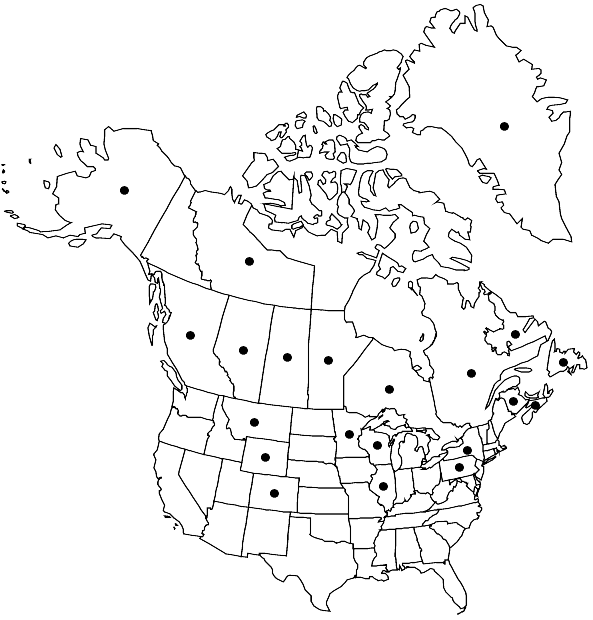Difference between revisions of "Polytrichastrum longisetum"
Mem. New York Bot. Gard. 21(3): 35. 1971,.
FNA>Volume Importer |
imported>Volume Importer |
||
| (5 intermediate revisions by 2 users not shown) | |||
| Line 6: | Line 6: | ||
|place=21(3): 35. 1971, | |place=21(3): 35. 1971, | ||
}} | }} | ||
| − | |basionyms={{Treatment/ID/ | + | |basionyms={{Treatment/ID/Basionym |
|name=Polytrichum longisetum | |name=Polytrichum longisetum | ||
|authority=Bridel | |authority=Bridel | ||
| + | |rank=species | ||
| + | |publication_title=J. Bot. (Schrader) | ||
| + | |publication_place=1800(1): 286. 1801 | ||
}} | }} | ||
|synonyms={{Treatment/ID/Synonym | |synonyms={{Treatment/ID/Synonym | ||
|name=Polytrichum formosum var. aurantiacum | |name=Polytrichum formosum var. aurantiacum | ||
|authority=(Bridel) C. J. Hartman | |authority=(Bridel) C. J. Hartman | ||
| + | |rank=variety | ||
}} {{Treatment/ID/Synonym | }} {{Treatment/ID/Synonym | ||
|name=Polytrichum gracile | |name=Polytrichum gracile | ||
| − | |authority= | + | |authority= |
| + | |rank=species | ||
}} {{Treatment/ID/Synonym | }} {{Treatment/ID/Synonym | ||
|name=Polytrichum gracile var. anomalum | |name=Polytrichum gracile var. anomalum | ||
|authority=(Milde) I. Hagen | |authority=(Milde) I. Hagen | ||
| + | |rank=variety | ||
}} | }} | ||
|hierarchy=Polytrichaceae;Polytrichastrum;Polytrichastrum longisetum | |hierarchy=Polytrichaceae;Polytrichastrum;Polytrichastrum longisetum | ||
| Line 42: | Line 48: | ||
-->{{#Taxon: | -->{{#Taxon: | ||
name=Polytrichastrum longisetum | name=Polytrichastrum longisetum | ||
| − | |||
|authority=(Bridel) G. L. Smith | |authority=(Bridel) G. L. Smith | ||
|rank=species | |rank=species | ||
| Line 56: | Line 61: | ||
|publication year= | |publication year= | ||
|special status= | |special status= | ||
| − | |source xml=https:// | + | |source xml=https://bitbucket.org/aafc-mbb/fna-data-curation/src/2e0870ddd59836b60bcf96646a41e87ea5a5943a/coarse_grained_fna_xml/V27/V27_156.xml |
|genus=Polytrichastrum | |genus=Polytrichastrum | ||
|species=Polytrichastrum longisetum | |species=Polytrichastrum longisetum | ||
Latest revision as of 21:24, 5 November 2020
Plants medium to large, mostly unbranched, dark green, in loose tufts. Stems 2–5(–10) cm. Leaves 5–10 mm, somewhat contorted and flexuose when dry, spreading-recurved when moist; sheath short, oblong, yellowish (in what has been known as Polytrichum gracile var. anomalum) weakly differentiated and tapering to the blade, hyaline margined, the hinge-tissue often not well developed; blade narrowly lanceolate; marginal lamina typically broad and often somewhat inflexed, 5–9(–12) cells wide (to 20 cells wide in var. anomalum), plane to erect, sharply toothed nearly to the sheath, the teeth composed of a single, elongate tooth cell, or at times less strongly toothed to denticulate; costa excurrent, ending in a short awn; lamellae in profile entire or finely serrulate, 3–7 cells high, the marginal cells in section ovate to elliptic, scarcely enlarged, usually taller than wide, sometimes slightly thicker-walled, smooth; sheath cells short- rectangular, (30–)40–60 × 14–18 µm (ca. 3–4:1); cells of the marginal lamina 15–18 µm (larger in var. anomalum), quadrate to transversely elongate; perichaetial leaves similar to the vegetative leaves or slightly larger. Seta 4–7 cm tall, typically exceeding the leafy shoots in length, yellowish, reddish brown below. Capsule 3–5 mm, slender to ovoid, (4–)5–6-angled, yellowish brown; hypophysis cylindric, narrower than the urn; exothecium smooth, the cells irregularly rectangular, not bulging, without thin spots; peristome pale, 400–600 µm, divided to 0.8, the teeth ca. 50, somewhat irregular in size and shape, rather slender. Spores 18–28 µm.
Habitat: Moist acidic to basic peaty sites, hummocks, meadows and wet tundra (D. G. Long 1985)
Elevation: moderate to high elevations
Distribution

Greenland, Alta., B.C., Man., N.B., Nfld. and Labr., N.W.T., N.S., Ont., Que., Sask., Alaska, Colo., Ill., Minn., Mont., N.Y., Pa., Wis., Wyo., s temperate South America, Europe, n Asia (Japan, Korea, New Guinea), Pacific Islands (New Zealand).
Discussion
Polytrichastrum longisetum is a circumpolar boreo-temperate species, and is also found in the Southern Hemisphere. In northern Europe, the species occurs on well-drained acidic soil in heaths and moorlands, also in woods; the seta is often conspicuously longer than the leafy shoots (whence the name), and the capsules broadly ovoid, widest below the middle. As represented in eastern North America, P. longisetum is similar in habit and habitat to P. formosum var. densifolium and P. pallidisetum, but differs in the less strongly differentiated leaf sheath, short-rectangular sheath cells, and broad marginal lamina. Both P. formosum and P. longisetum have the marginal cells of the lamellae scarcely differentiated, in profile entire to finely serrulate by the projecting leading angles of the marginal cells; in P. pallidisetum the lamellae are crenulate in profile, and the marginal cells in cross-section broadened, flat-topped to shallowly retuse. Specimens identified as Polytrichum gracile var. anomalum, found in the wettest habitats, even submerged, are sometimes startlingly Atrichum-like in appearance. The leaf sheath is weakly developed and scarcely broader than the blade, the 1-stratose lamina is up to 20 cells wide, and the lamellae are few in number and confined to the median portion of the blade.
Selected References
None.